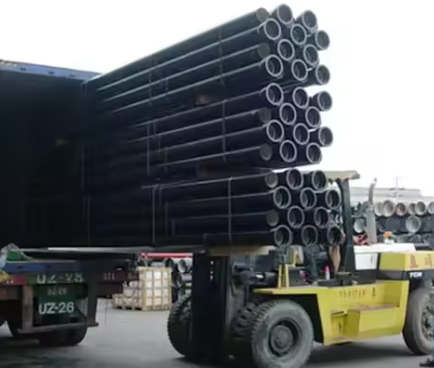Ductile iron, also known as nodular or spheroidal graphite iron, exhibits a density that typically ranges between 7.05 and 7.30 g/cm³ (7.05–7.30 Mg/m³), varying with grade, composition, and processing conditions. Industry standards such as ASTM A536 routinely specify a nominal density of 0.256 lb/in³ (7.10 g/cm³) for common grades like 60-40-18, 65-45-12, and 80-55-06.

Introduction
Ductile iron is a cast iron variant distinguished by its spheroidal graphite inclusions, which impart enhanced ductility and impact resistance compared to gray iron. Accurately knowing its density is essential for weight-sensitive designs—impacting component mass, material cost, and strength-to-weight calculations.
Density of Ductile Iron
Typical Range
-
7.05–7.25 g/cm³ (440–452 lb/ft³) is often cited as the general density window for most ductile iron variants.
-
7.10–7.20 g/cm³ (0.256 lb/in³) appears consistently in data sheets for ASTM A536 grades, reflecting tight control in commercial production.
-
Some foundry data report densities as high as 7.30 g/cm³ (119.6 lb/ft³) for specialized low-shrinkage castings.
Unit Conversions
| Unit | Value per cm³ | Value per in³ | Value per m³ |
|---|---|---|---|
| g/cm³ | 7.05–7.30 | — | — |
| lb/in³ | — | 0.255–0.260 | — |
| kg/m³ (Mg/m³) | — | — | 7050–7300 kg/m³ |
| lb/ft³ | — | — | 440–452 lb/ft³ |
Factors Affecting Density
-
Composition & Grade: Variations in carbon, silicon, and manganese levels alter the metal matrix and graphite nodularity, shifting density by up to ±0.1 g/cm³.
-
Porosity & Shrinkage: Higher casting porosity or shrinkage defects decrease effective density in finished parts.
-
Heat Treatment: Austempering or other thermal processes can induce microstructural transformations, marginally affecting specific gravity by altering phase fractions.
Comparison with Other Materials
| Material | Density (g/cm³) | Typical Application |
|---|---|---|
| Ductile Iron | 7.05–7.30 | Pipes, gears, automotive parts |
| Gray Cast Iron | 6.90–7.20 | Engine blocks, machine bases |
| Steel (C-Mn) | 7.75–8.05 | Structural beams, shafts |
| Aluminum (6061) | 2.70 | Aerospace, marine components |
| Copper | 8.90 | Electrical wiring, heat exchangers |
Applications Where Density Matters
-
Pipeline Projects: Ductile iron water and gas pipes balance strength and weight; their 7.1 g/cm³ density aids installation planning and structural design.
-
Automotive Components: Control arms, crankshafts, and suspension parts leverage high density for inertia and vibration damping.
-
Heavy Machinery: Gearboxes and pump housings exploit ductile iron’s stiffness-to-weight ratio for longevity under load.
Frequently Asked Questions
Q1: Why does ductile iron have a higher density than aluminum?
A1: Ductile iron’s iron-rich matrix (≈90% Fe) yields densities around 7.1 g/cm³, significantly above aluminum’s 2.7 g/cm³ due to aluminum’s lighter atomic mass and lower alloying content.
Q2: Can density variations affect mechanical performance?
A2: Yes—lower density from porosity or shrinkage can reduce load-bearing capacity and fatigue life, making strict density control critical in aerospace and automotive castings.
Q3: How do I measure ductile iron density in a finished part?
A3: Common methods include Archimedes’ principle (weigh-in-air vs. submerged) and precise volume measurement via 3D scanning or geometric calculations.
Q4: Are there grades of ductile iron with noticeably different densities?
A4: Most ASTM A536 grades cluster around 7.10 g/cm³, but specialized low-shrinkage or high-alloy variants can edge toward 7.25–7.30 g/cm³.
Q5: Does temperature affect ductile iron density?
A5:Thermal expansion can reduce density by approximately 0.02 g/cm³ between room temperature and 200 °C, a factor in high-temperature applications.

